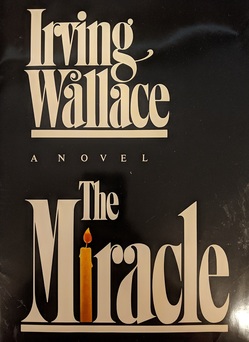Have you ever seen an author press kit? Me neither. At least I hadn’t until I noticed a copy of Irving Wallace’s press kit for his novel, The Miracle. Produced by Wallace’s publisher E.P. Dutton, Inc. in New York, the kit was meant to be sent to book sellers both to entice them to order the book for their retail locations, but also to provide stock material those potential book sellers could use to sell the book in their stores.

The press kit arrives in a glossy 8.5″x11″ folder using the same fonts and imagery as the novel’s cover. Inside the kit are two pockets, one on each facing cover. In the left side, the kit includes the text of an interview with Wallace about his new novel. The interview, often titled “Questions and Answers” is a common feature of book publisher publicity and promotional materials. The Q&A interview is created for every single book whether or not a full press kit is developed. Additionally, the left-hand pocket includes a 5″x7″ glossy black and white image of Irving Wallace looking particularly authorly (Yes. I just made that up. Go with it.) in his suit and tie and holding his signature pipe. His smile is friendly and affable if not somewhat goofy (in a good way). The photographer managed to capture an image of Wallace in which he looks a respectable professional, but also relatable.

On the right-hand side of the folder, the pocket contains three more items. The first is a glossy 5″x7″ black and white photo of the book’s cover. Next is a press release from Dutton providing the sales pitch for the book with a synopsis description that hooks the reader (the back cover text as well). The “Dutton News” also lists the main cast members of the book and the requisite price, ISBN, Publication date, and so forth. Finally, behind the press release is a 3-page biography of Irving Wallace highlighting his long and varied writing career and impressive bibliography of magazine articles, short stories, fiction and non-fiction works to date.

Since the press kit for The Miracle was produced in 1984 with the release of the novel, I imagine that press kits have changed significantly in the digital era. Although today’s press kits likely include much the same information, it is, no doubt, sent electronically rather than physically through the good ol’ snail mail. That’s too bad, really. Having gone through this press kit I think there is something particularly endearing about the physical artifact–its tactility: the smooth, glossy surface of the folder; its smell: the faint chemical smell of the photo emulsion and the smell of good quality paper with actual typed ink; and its visual appeal: the document design of each item included, the photographic evidence of a real person and a real book and even the sense that you’re holding the essence of the book in your hands with the kit cover echoing the novel cover. All of these are part of what makes us still buy physical books even when we own electronic readers, cell phones and tablets that double as readers, and a host of other digital equipment that lets us “read” a book today.